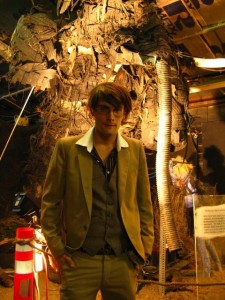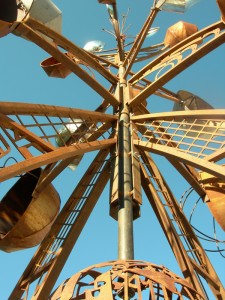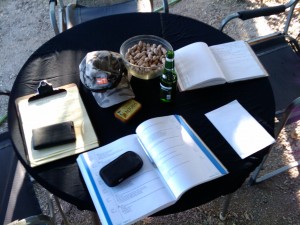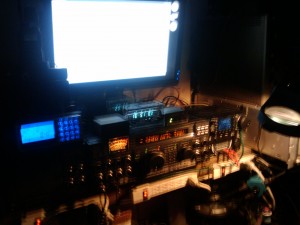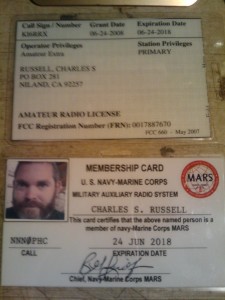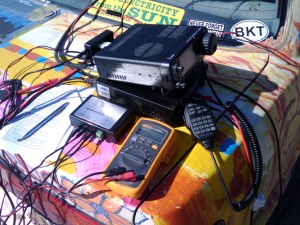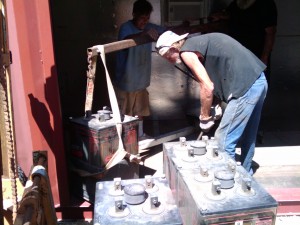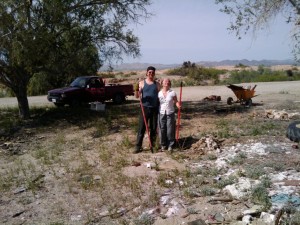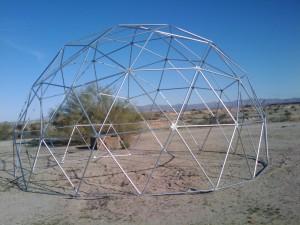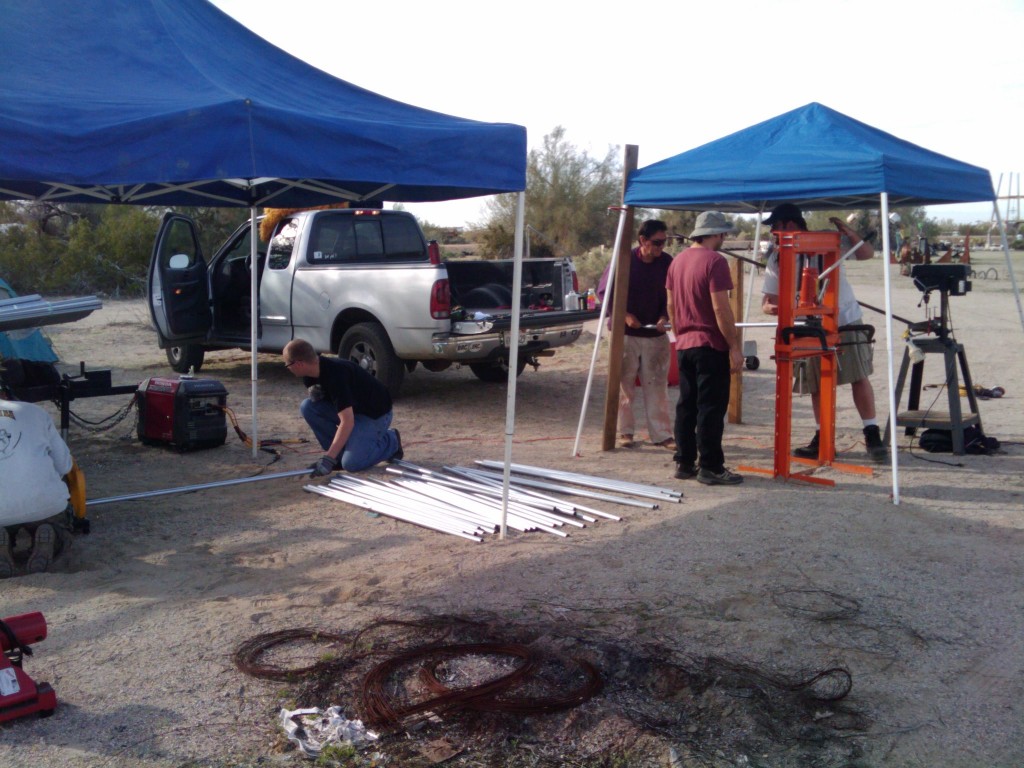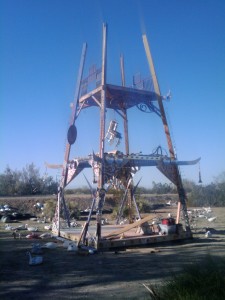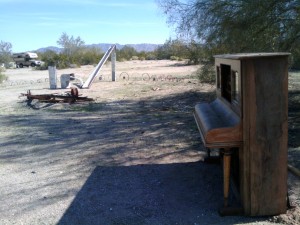SEVERAL DAYS LATER….
You can spend thousands, even tens or hundreds of thousands on this hobby. Some call it a rich man’s game. I got into it more for the thrill of cobbling together circuitry for under $20 using scrounged electronics, Altoids tins and scrap wire. Nevertheless, the seduction of fine equipment is stong. In my irrational exuberance following receipt of my FCC license, I treated myself to what I thought was some reference-quality HF equipment – for reference purposes, of course – to help in the design, construction, testing and operation of the aforementioned Altoids tins crammed full of hand-wound coils and transistors stolen from abandoned TVs.
The expensive stuff never really worked. Well, at least not terribly well. I spent a lot of time learning the ins and outs of the mighty Yaesu FT-1000, even the features I never thought I’d use. I spent nights scanning the bands during the long lull between sunspot cycles 23 and 24, when the airwaves were practically dead from 160m all the way to 6m. Whether it was just the absence of sunspots, the antenna or the transceiver I’ll never be completely sure. At nine months old, the antenna – an MFJ 1798 multiband vertical – took wind damage and seemed to have given up its ghost. The transceiver may have been damaged at that point, too. I’m sure at one point I tried the automatic antenna tuner which, if activated without an antenna connected, would have certainly put the final hurts on the Yaesu. In any case the HF rig sat in disuse for about a year before I tired again in vain to receive any signal using a variety of antennas and finally realized its front end was shot.
Anticipating, however, that I would one day start riding the low HF bands again, I spent a rainy day picking through some bits I had been collecting over the months, components of wire antennas – insulators, romex wire, antenna rope, and a flagpole pulley, cleat and halyard – and whipped up a simple 80m dipole. I knew at some point I’d just break down and buy another HF transceiver, probably something portable to augment the heavy, base-station-only FT-1000.
At the Yuma hamfest I had spotted some interesting (and affordable) screwdriver antennas and asked the designer to demonstrate one. We went out after closing to the RV camping area, a few acres of mobile stations of all kinds bristling with roughly a bazillion antennas reaching for the zenith. He showed me how the antenna was mounted, how the motor controller was controlled by an aftermarket antenna tuner that was, in turn, controlled by his HF/VHF/UHF radio: an Icom IC-7000. I watched in amazement as that small antenna, just a few feet off the dirt, tuned itself to perfect 1.0-to-1 SWR on any frequency I could name – from 1.84 MHz all the way up to fifty-something. Granted, you had to tune it again every time you dialed in a new frequency, but the worst SWR I saw was about 1.2-to-1, which was far better than most anything I had ever used. I was sold. the next day I bought a complete copy of that rig: radio, antenna and tuner, plus some mounting brackets and adapters I needed to stock up on.
Back home, somewhat exhausted from absorbing so much new information all weekend, I crammed through the IC-7000 manual and did a smoke check on it with the 80m dipole – straight, no chaser, no tuner. I was blown away by all the signals I was hearing now, many of them on bands that this particular antenna shouldn’t even be receiving at all! Let the fun begin! I listened to everything from domestic and Mexican AM broadcasts to 80m, SW (Taiwan, Portugal, The Vatican, Cuba, etc,) and 40m, 20m, 17m…. With a CW contest in progress, every band seemed to be gushing waterfalls of Morse code. I was tempted to make a call out but decided to just go to bed, let the magic of a good night’s sleep do its work on my weary hippocampus, and take on the world the next morning.
The following day brought some landmark events. I made my first HF QSO with a station over 600 miles away (somewhat embarrassingly, this took place at a frequency my General Class license does not permit me to transmit on, which fact was gently and politely pointed out to me by the others,) and promptly checked in to two local ARES / RACES HF nets (with less-than-perfect signal reports, but who said the first time had to be perfect?) immediately afterward. Next was the big hurdle, the actual driving force behind my race to get back onto 80m: a MARS training net at 0100Z.
MARS (which stands for Military Auxiliary Radio System, a long-standing symbiosis between the various military branches and participating volunteer amateur radio stations) uses frequencies not regulated by the FCC; they are administrated by the Department of Defense. Your garden-variety amateur radio equipment is typically tx-blocked at these frequencies to prevent “accidents.” But acceptance into the MARS program, even as a trial member, costitutes permission to *legally* hack your radio to allow transmission on non-ham frequencies. You’ll just be dealing with Military Police instead of the FCC if you do a no-no.
I knew the out-of-band mod for the IC-7000 was fairly straightforward – removal or at least disconnection of a single diode. I quickly found the necessary info online and effected the tx-unlock with only a few cuss words and moments of head-scratching. Since calling for a radio check on military frequencies was something I wasn’t sure I was authorized to do, I’d have to wait until the training net began to know if I’d hit the sweet spot or not. To my great relief, everything worked fine. I checked into my first MARS net, was able to read all stations but could only be heard by a few. The protocol is quick and dry and business-only and not something I was yet used to, but I seem to have gotten through it OK.
So, four “firsts” for me in HF operation, all in one day. That ain’t bad. Oh, and I think the point I was trying to make was this: all of this was possible due to a hastily thrown-together, UN-tuned, UN-tweaked, simple wire antenna made of about $15 worth of parts.
